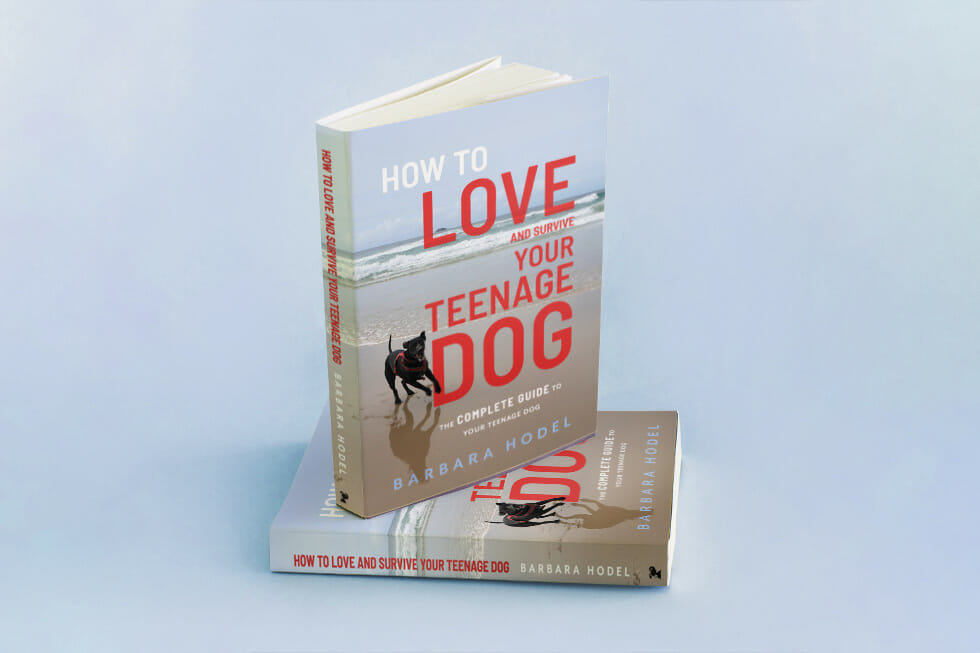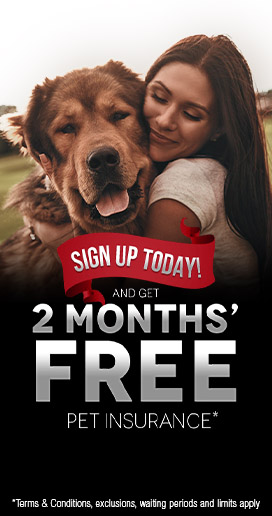
Teenage dogs at the vet and how to help them cope!
Teenage dogs can be challenging at the best of times and vet visits can be daunting.
Dogs enter the teenage phase around 7 to 12 months and reach social maturity between 24 and 36 months. Smaller breeds and working dogs become teenagers earlier and mature earlier, too. Larger breeds and specifically gundogs, enter the teenage phase later and mature later.
The main thing we need to understand is that teenage dogs are not ‘difficult’ on purpose. Their brains are under construction and because the front part of the brain that is responsible for controlling emotions matures last, we see them reacting in seemingly irrational ways. This brain development is also responsible for their selective hearing, ‘forgotten’ training and getting spooked by random people and things during fear phases. This is normal and has physiological reasons. Knowing the physiological reason behind these challenges should make it easier for us to be patient and understanding of the hard time our teenage dogs are going through.
Vet visits are difficult part of life for most dogs and even more so for bouncy teenage dogs. But all dogs need to go to the vet when they are sick or injured and when they need their annual check-up or vaccination. It is extremely stressful for our dog (and us) if our dog is overly scared and becomes a shivering mess at the vet. It is normal for dogs to be a little stressed or apprehensive at the vet given the strange sights, smells and sounds – but if they are petrified on arrival it is heartbreaking to watch and it can be difficult for the vet to diagnose or provide treatment.
Luckily, we can do something about this with a lot of social visits when our dogs are puppies and teenagers. We need to take our young dogs to the vet regularly and start social vet visits early to prevent them from becoming fearful in this environment. I recommend social vet visits on a weekly basis for puppies and teenage dogs.
We start with just walking into the clinic, giving our dog a few treats and leaving again. We repeat this a few times until they appear to be enjoying going in. We then ask the nurses or receptionist to give them treats. If our dog has experience with getting on objects, we can ask them to get on the scale and give them a treat for doing so. Once they are relaxed, we can start going into the treatment rooms and meet the vet.
We need to make the vet visit as pleasant as possible by being generous with our treats and choosing procedures that are less invasive. There are more-and-more vets who offer a version of ‘fear free pets’ vet visits (check for these vets in your area). Additionally, a well-run puppy class at the vet of your choice can help to create a positive association, too.
There is also a ‘phenomenon’ that works in our favour, called latent inhibition. This means if our dog has had a lot of good experiences at the vet, one bad experience will not completely ruin it. They most likely will maintain a positive attitude despite the aversive procedure. But, we also need to be aware that there is ‘one event learning’ or ‘flashbulb memories’ and that despite all our best efforts one negative experience can ruin all of our hard work in creating positive associations. These ‘one event learning’ events are extremely difficult to overcome. So if we can we should try to avoid them and teaching the ‘head-rest’ as explained below can help with that.
Handy tips for the vet
Step-on
Teaching our dogs to step onto the scales at the vet starts with a plank at home. This is the first step towards teaching them to step onto unusual things. We can use luring for this: hold a treat in front of their face and guide them onto the plank. If they are not comfortable with this, we might only ask for the front feet to begin with and then gradually ask them to put their hind feet on. The hand signal is pointing to the plank/scales, similar to go-to-mat. If they have a go-to-mat cue, putting a mat on the plank/scales to start with can help. Once they are comfortable stepping onto things, we can add a verbal cue with it, like step-on. We can also practice this on our walks by asking our dogs to step-on to different surfaces and mark and reinforce when they do. Once our dog understands the step-on cue at home and is comfortable at the vet, we can ask them to step-on to the vet scale. Keep it short in the beginning: we should lure them into stepping onto it, then allow them to step off. Then we can ask for them to stay there for a few seconds and gradually we can ask them to spend more time on the scale.
Head-rest
We teach our dog to rest their head in our hand or on a chair as a way to teach accepting touch from the vet or other health professional; it is their way of expressing consent. Throughout teaching head-rest, we must always be vigilant of our dog’s comfort, and respect that they can say ‘no’ and withdraw consent to be touched. This means they have more control over what happens to them. If they leave their head in our hand or on the chair, they are saying it is ok for the vet to proceed. If they take their head away, it means no and the vet needs to stop what they are doing. Using a chair or the hand is a personal preference, as both work the same. If using a chair, I recommend putting a towel on the chair so we can take the towel to the vet and they still understand the behaviour in a different context.
Unfortunately, sometimes there is an emergency and things need to be done before we can obtain our dog’s consent and condition the vet to be a non-scary place. There are different ways of dealing with this. If we are doing routine things like injections that are not very time-sensitive, I would stick to the training plan and just defer for a few days or a week and do a lot more training to get them ready. In an emergency situation there are medications that can help or sedation. Talk to your vet about what is appropriate to prevent a negative association between them and your dog.
To teach head-rest we use shaping, by breaking the behaviour down into small steps. The first step is look-at-hand/chair, which we mark and reinforce. Mark and reinforce means we either use a marker word like ‘yes’ (or clicker) to tell our dog they have done the right thing and then follow up with a treat (the reinforcer). Then we move on to approach-hand/chair (mark and reinforce), touch-hand/chair (mark and reinforce) and finally leave-chin-in-hand/chair (mark and reinforce). Once they understand that we want their head to rest in our hand or on the chair we add the verbal cue head-rest. Check our youtube channel for a step-by-step video on teaching head-rest.
Muzzle training
Dogs, contrary to humans, do not have a negative preconception with the muzzle (although they can develop one with negative experiences). For them it is just another piece of equipment if introduced carefully. It is well worth training our dog on a muzzle because, in the case of an injury, it will make a vet visit much less stressful. If our dog is injured and in pain, even the most placid dog might bite and make treatment difficult or impossible. In these cases, the vet will use a muzzle to protect themselves. If our dog is used to the muzzle then we have one less stressor. If they are not, then the muzzle will make an already-stressful situation worse.
Muzzle training requires desensitising and counter-conditioning. We start by showing them the muzzle (mark and reinforce). We bring the muzzle a bit closer, they might look at it (mark and reinforce) or sniff it (mark and reinforce). Then we put a few treats in the muzzle and let them eat the treats. Eventually they will put their nose in it (mark and reinforce) and keep it there for longer (mark and reinforce). We then bring the strap behind their head (mark and reinforce), close the strap (mark and reinforce), and gradually build up the duration of it staying on. Every step is repeated and reinforced as many times as necessary so they don’t get stressed and it is a positive experience. For more information on muzzle training check out the Muzzle Up Project.
With early and ongoing social visits to the vet, teaching them the basics such as stepping onto a scale and a head rest to accept handling from the vet, visits should become less stressful for all, the humans, dogs and the vet. Muzzle training has many advantages and should be part of every dog’s training. If done properly it can be invaluable in medial and other emergencies. Most of all keep things positive and don’t rush it.
(Edited extract of How to Love and Survive your Teenage Dog – Barbara Hodel)
Get the latest Pet Insider Tips & News
We offer award-winning* pet insurance policies to protect your furry friend’s health and wellbeing. Get a quote today and give your pets the care they deserve.
Archives
Categories
- Cat Care (64)
- Cats (1)
- Dog Care (124)
- Guides (28)
- Health and Nutrition (200)
- Lifestyle and Activities (219)
- Media Release (24)
- Pet Care (246)
- Rescue Dogs (1)

